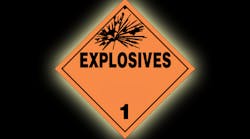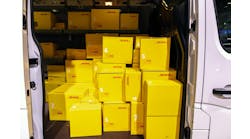Shippers and receivers of hazardous materials often deal with shipments that don’t meet the DOT's standards for hazmat packages. Packages are commonly undeclared, mis-declared, or damaged. These mistakes are especially common in the reverse logistics supply chain, since customers may not have the training needed to identify their hazmat shipping responsibilities before returning a product by mail.
Undeclared Hazmatsare likely to be packaged incorrectly and may have been mishandled. If these oversights lead to an incident in the transportation cycle, emergency personnel will not have the information needed to properly respond to the situation.
Recipients who discover an undeclared shipment of hazmat must notify the DOT on a Hazardous Materials Incident Report (Form 5800.1). They should also discuss the matter with their supplier and the transporter. It may have been a simple mistake, but steps should be taken to prevent it from happening again.
Mis-declared Hazmatsare those offered for transportation without being packaged correctly or with inaccurate hazard communications (marks, labels, paperwork, etc.) that don't match the hazards of the material. In the event of an incident, first responders will again lack the information needed. Shipping mis-declared or improperly labeled hazmat is just as much a violation of the U.S. DOT's Hazardous Materials Regulations (HMR) as an undeclared shipment. [49 CFR 171.2]
Recipients of improperly labeled or mis-identified hazmat packages should speak with their supplier or the customer who sent the package and make the transporter aware of the situation.
Damaged/Leaking Packages give recipients several options:
· Refuse to accept the shipment.
· Accept the shipment, just like accepting a regular package, and do what you normally do with your hazmat.
· Accept the shipment, then re-pack it and ship it out with your hazardous wastes.
Discovery after the Fact
So far, we've discussed what to do if you discover a problem right away, as the goods are being delivered. What about if you only find out about it later? In that case, your options are more limited.
You can't just refuse to accept the shipment, because it is already in your possession. You can either find a use for it or get rid of it. If you get rid of it, either as a waste, return-to-sender, or resale, it is important to remember that you're now offering a new shipment of hazmat. It is now your responsibility to ensure any mistakes made classifying, packaging, or labeling the shipment are corrected before you re-ship the package.
Keep in mind that if you decide to dispose of the hazmat, you must treat it as a waste and must follow all of the applicable RCRA Subtitle C laws and regulations for hazardous waste management.
Re-shipping Problem Hazmat
Re-shipping a package of hazmat that was received as damaged, mis-declared, or undeclared can be problematic. First, if the package was undeclared or misidentified, you may not know what material or hazard you are dealing with. This makes packaging and labeling for re-shipment very difficult.
If it's an unknown material, and you're not managing it as waste, then you'll have to take steps to figure out what the material is. The easiest thing to do is contact the original consignor for a Safety Data Sheet or any other information he or she can provide. You can also send out a small sample and have it analyzed. If you do decide to manage it as a waste, there is a little flexibility. See 49 CFR 172.101(c)(11) and 173.11.
If you do know what it is, but it's not in the right kind of sturdy packaging, then it is your responsibility to determine authorized packaging, correct markings and labels, and prepare new shipping papers and emergency response information before re-sending the package.
James Griffin is a hazmat specialist with Lion Technology, Inc., which offers a series of Hazardous Materials Transportation Certification Workshops nationwide.



